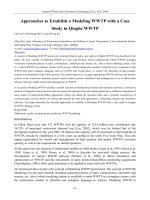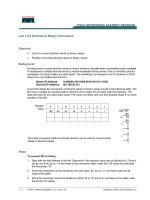2 theoretical approaches to l2
Bạn đang xem bản rút gọn của tài liệu. Xem và tải ngay bản đầy đủ của tài liệu tại đây (1.35 MB, 43 trang )
Explaining Second Language
Learning
Contexts for Language Learning
Behaviorism
Innatism
Cognitive/developmental perspective
Information Processing
Connectionism
The Competition Model
The Sociocultural Perspective
1/43
Contexts for Language Learning
A child or adult learning a second language
is different from a child acquiring a first
language in terms of both
1) learner characteristics
and
2) learning conditions
2/43
Differences in Learning L1 & L2
Learner Characteristics
1. Knowledge of another
language
2. Cognitive maturity
3. Metalinguistic awareness
4. World Knowledge
5. Anxiety about speaking
L1
Child
L2
Child
(informal
)
Adolescent
(formal)
?
+
-
-
+
+
-
?
+
+
-
-
+
+
-
-
+
+
-
3/47
Adult
(informal
)
+
Differences in Learning L1 & L2
Learning Conditions
6. Freedom to be silent
7. Ample time & contact
8. Corrective feedback:
(grammar and
pronunciation)
9. Corrective feedback:
(meaning, word choice,
politeness)
10. Modified input
L1
L2
Child
Child
(informal)
Adolescent
(formal)
+
+
-
+
+
-
?
-
-
+
-
+
+
+
+
+
+
+
+
Child-directed
speech
Adult
(informal
)
-
Foreigner talk or
Teacher talk
4/47
Differences in Learning L1 & L2
Summary:
SLA (Second Language Acquisition) theories
need to account for language acquisition by
learners with a variety of characteristics and
learning in a variety of contexts.
5/43
Behaviorism
Four characteristics of behaviorism:
1) imitation, 2) practice, 3) reinforcement, and
4) habit formation
Brooks (1960) & Lado (1964):
- emphasizing mimicry and memorization
(audiolingual teaching methods)
6/43
Behaviorism / CAH
A person learning an L2 starts off with the habits
formed in the L1 and these habits would interfere
with the new ones needed for the L2.
Behaviorism was often linked to the Contrastive
Analysis Hypothesis (CAH):
It predicts that where there are similarities between
the L1 and the target language, the learner will
acquire target-language structures with ease; where
there are differences, the learner will have difficulty.
7/43
Behaviorism / CAH
Criticisms about the CAH:
Though a learner’s L1 influences the acquisition of an L2,
researchers have found that L2 learners do not make all
the errors predicted by the CAH.
1.
Many of their errors are not predictable on the basis of
their L1 (e.g. ‘putted’; ‘cooker’ meaning a person who
cooks; ‘badder than’)
2.
Some errors are similar across learners from a variety of
L1 backgrounds (e.g. he/she; “th” sound; the use of the
past tense; the relative clauses)
8/43
Behaviorism / Summary
The L1 influence may not simply be a matter of the transfer
of habits, but a more subtle and complex process of
- identifying points of similarity,
- weighing the evidence in support of some particular
feature, and
- reflecting (though not necessarily consciously) about
whether a certain feature seems to ‘belong’ in the L2.
By the 1970s, many researchers were convinced that
behaviorism and the CAH were inadequate explanations for
SLA.
9/43
Innatism
Universal Grammar (UG) in relation to
second language development
Competence vs. Performance
Krashen’s “monitor model”
10/43
Innatism:
Universal Grammar
UG and SLA
1.
Chomsky has not made specific claims about the implications
of his theory for second language learning.
2.
Linguists working within the innatist theory have argued that
UG offers the best perspective to understand SLA. UG can
explain why L2 learners eventually know more about the
language than they could reasonably have learned (i.e. UG
can explain L2 learners’ creativity and generalization ability).
3.
Other linguists argue that UG is not a good explanation for
SLA, especially by learners who have passed the critical
period (i.e. CPH does not work in SLA).
(* Note: See Chapter 3: Age of acquisition and CPH)
11/43
Innatism:
Universal Grammar
How UG works in SLA:
Two different views 1.
The nature and availability of UG are the same in L1
and L2 acquisition.
Adult L2 learners, like children, neither need nor
benefit from error correction and metalinguistic
information. These things change only the superficial
appearance of language performance and do not
affect the underlying competence of the new language
(e.g., Krashen’s “monitor model”).
12/43
Innatism:
Universal Grammar
How UG works in SLA:
Two different views -
2.
UG may be present and available to L2 learners, but its
exact nature has been altered by the prior acquisition of
the first language.
L2 learners need to be given some explicit information
about what is not grammatical in the L2. Otherwise, they
may assume that some structures of the L1 have
equivalents in
the L2 when, in fact, they do not.
13/43
Innatism:
Competence vs. Performance
Competence:
It refers to the knowledge which underlies our ability
to use language.
Performance:
It refers to the way a person actually uses language
in listening, speaking, reading, and writing.
Performance is subject to variations due to
inattention, anxiety, or fatigue whereas competence
(at least for the mature native speaker) is more
stable.
14/43
Innatism:
Competence vs. Performance
SLA researchers from the UG perspective (innatism)
are more interested in the language competence (i.e.,
knowledge of complex syntax) of advanced learners
rather than in the simple language of early stage
learners.
Their investigations often involve comparing the
judgments of grammaticality made by L2 and L1
learners, rather than observations of actual language
performance (i.e., use of language).
15/43
Innatism:
Krashen’s “monitor model” (1982)
The acquisition-learning hypothesis
The monitor hypothesis
The natural order hypothesis
The input hypothesis
The affective filter hypothesis
16/43
Innatism:
Krashen’s “monitor model”
The acquisition-learning hypothesis
Acquisition: we acquire L2 knowledge as we are exposed to
samples of the L2 which we understand with no conscious
attention to language form. It is a subconscious and intuitive
process.
Learning: we learn the L2 via a conscious process of study
and attention to form and rule learning.
Krashen argues that “acquisition” is a more important
process of constructing the system of a language than
“learning” because fluency in L2 performance is due to what
we have acquired, not what we have learned.
17/43
Innatism:
Krashen’s “monitor model”
The monitor hypothesis
The acquired system acts to initiate the speaker’s
utterances and is responsible for spontaneous language
use, whereas the learned system acts as a “monitor”,
making minor changes and polishing what the acquired
system has produced.
Such monitoring takes place only when the speaker/writer
has plenty of time, is concerned about producing correct
language, and has learned the relevant rules.
18/43
Innatism:
Krashen’s “monitor model”
The natural order hypothesis
L2 learners acquire the features of the TL in
predictable sequences.
The language features that are easiest to state (and
thus to ‘learn’) are not necessarily the first to be
acquired.
e.g. the rule for adding an –s to third person
singular verbs in the present tense
19/43
Innatism:
Krashen’s “monitor model”
The input hypothesis
Acquisition occurs when one is exposed to language
that is comprehensible and that contains “i +1”.
If the input contains forms and structures just beyond
the learner’s current level of competence in the
language (“i +1”), then both comprehension and
acquisition will occur.
20/43
Innatism:
Krashen’s “monitor model”
The affective filter hypothesis
“Affect” refers to feelings, motives, needs, attitudes,
and emotional states.
The “affective filter” is an imaginary/metaphorical
barrier that prevents learners from acquiring language
from the available input.
Depending on the learner’s state of mind, the filter
limits what is noticed and what is acquired. A learner
who is tense, anxious, or bored may “filter out” input,
making it unavailable for acquisition.
21/43
Innatism:
Krashen’s “monitor model”
Summary
Krashen’s “monitor model” (i.e., acquisition vs. learning,
monitor, natural order, comprehensible input, and
affective filter) has been very influential in supporting
communicative language teaching (CLT), which focuses
on using language for meaningful interaction and for
accomplishing tasks, rather than on learning rules.
Krashen’s hypotheses are intuitively appealing, but
those hypotheses are hard to be tested by empirical
evidence.
22/43
Information processing
Cognitive psychologists working in this model
compare language acquisition to the capacities of
computers for storing, integrating, and retrieving
information.
do not think that humans have a language-specific module
(i.e. LAD) in the brain.
do not assume that ‘acquisition’ and ‘learning’ are distinct
mental processes.
see L2 acquisition as the building up of knowledge that can
eventually be called on automatically for speaking and
understanding (i.e., general theories of learning can
account for SLA).
23/43
Information processing
1.
Attention-processing
2.
Skill learning
3.
Restructuring
4.
Transfer appropriate processing
24/43
Information processing
Attention-processing:
This model suggests that learners have to pay attention at first
to any aspect of the language that they are trying to
understand or produce.
It also suggests there is a limit to how much information a
learner can pay attention to or engage in at one time.
Gradually, through experience and practice, information that
was new becomes easier to process, and learners become
able to access it quickly and even automatically.
This can explain why L2 readers need more time to understand
a text, even if they eventually do fully comprehend it.
25/43









